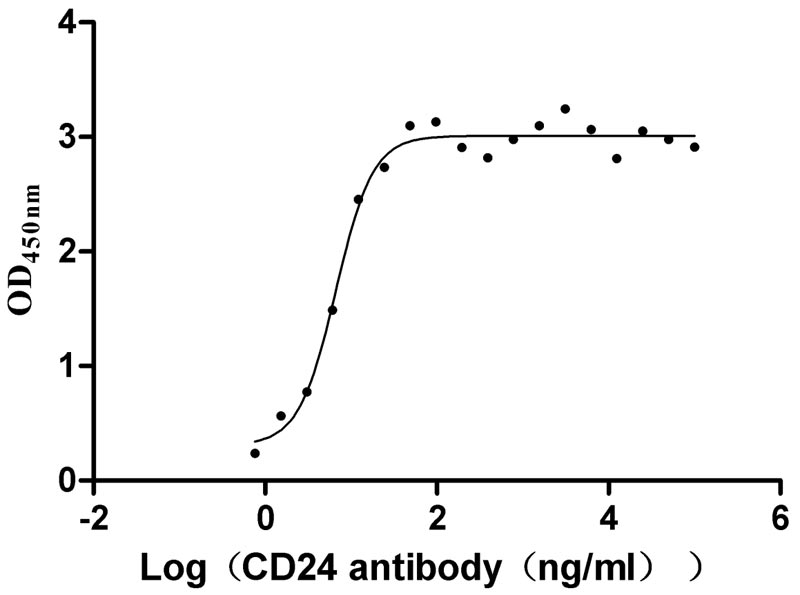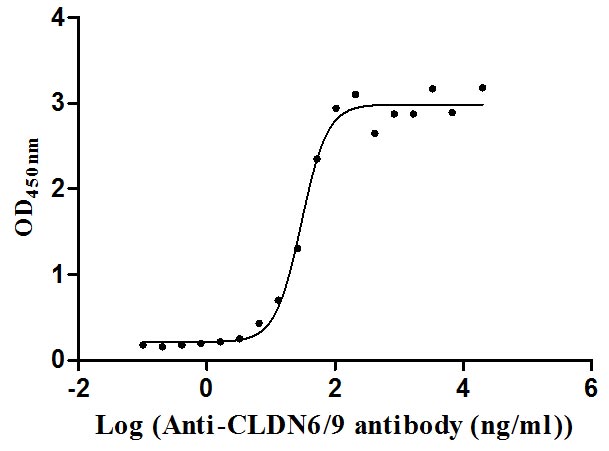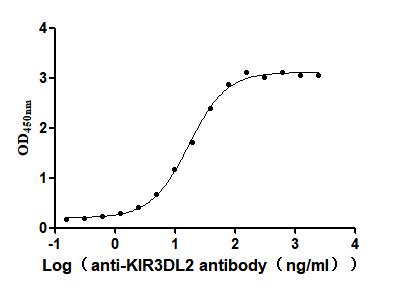Recombinant Arabidopsis thaliana LRR receptor-like serine/threonine-protein kinase ERECTA (ERECTA), partial
-
中文名稱:擬南芥ERECTA重組蛋白
-
貨號:CSB-EP671457DOA-B
-
說明書:
-
規格:
-
來源:E.coli
-
共軛:Avi-tag Biotinylated
E. coli biotin ligase (BirA) is highly specific in covalently attaching biotin to the 15 amino acid AviTag peptide. This recombinant protein was biotinylated in vivo by AviTag-BirA technology, which method is BriA catalyzes amide linkage between the biotin and the specific lysine of the AviTag.
-
其他:
產品詳情
-
純度:>85% (SDS-PAGE)
-
基因名:ERECTA
-
Uniprot No.:
-
別名:ERECTA; ER; QRP1; QRS1; TE1; At2g26330; T1D16.3LRR receptor-like serine/threonine-protein kinase ERECTA; EC 2.7.11.1; Protein QUANTITATIVE RESISTANCE TO PLECTOSPHAERELLA 1; Protein QUANTITATIVE RESISTANCE TO RALSTONIA SOLANACEARUM 1; Protein TRANSPIRATION EFFICIENCY 1
-
種屬:Arabidopsis thaliana (Mouse-ear cress)
-
蛋白長度:Partial
-
蛋白標簽:Tag?type?will?be?determined?during?the?manufacturing?process.
The tag type will be determined during production process. If you have specified tag type, please tell us and we will develop the specified tag preferentially. -
產品提供形式:Lyophilized powder
Note: We will preferentially ship the format that we have in stock, however, if you have any special requirement for the format, please remark your requirement when placing the order, we will prepare according to your demand. -
復溶:We recommend that this vial be briefly centrifuged prior to opening to bring the contents to the bottom. Please reconstitute protein in deionized sterile water to a concentration of 0.1-1.0 mg/mL.We recommend to add 5-50% of glycerol (final concentration) and aliquot for long-term storage at -20℃/-80℃. Our default final concentration of glycerol is 50%. Customers could use it as reference.
-
儲存條件:Store at -20°C/-80°C upon receipt, aliquoting is necessary for mutiple use. Avoid repeated freeze-thaw cycles.
-
保質期:The shelf life is related to many factors, storage state, buffer ingredients, storage temperature and the stability of the protein itself.
Generally, the shelf life of liquid form is 6 months at -20°C/-80°C. The shelf life of lyophilized form is 12 months at -20°C/-80°C. -
貨期:Delivery time may differ from different purchasing way or location, please kindly consult your local distributors for specific delivery time.Note: All of our proteins are default shipped with normal blue ice packs, if you request to ship with dry ice, please communicate with us in advance and extra fees will be charged.
-
注意事項:Repeated freezing and thawing is not recommended. Store working aliquots at 4°C for up to one week.
-
Datasheet :Please contact us to get it.
靶點詳情
-
功能:Receptor kinase that, together with ERL1 and ERL2, regulates aerial architecture, including inflorescence (e.g. shoot apical meristem-originating organ shape, elongation of the internode and pedicels, and adaxial-abaxial polarity), and stomatal patterning (e.g. density and clustering), probably by tuning cell division and expansion. Redundantly involved with ERL1 in procambial development regulation. Forms a functional ligand-receptor pair with EPF2 (AC Q8LC53). Modulates plant transpiration efficiency by controlling stomatal density, leaf photosynthetic capacity, epidermal cell expansion, mesophyll cell proliferation and cell-cell contact. A phloem-specific expression of ER is sufficient for proper inflorescence architecture. Probable major trait regulating canalization (maintenance of phenotype despite varying environment) in many aspect of the plant physiology (e.g. plant morphology, light-dependent leaves number, branch number, flowering time, phytate and mineral concentrations) by transducing microenvironmental variation into phenotypic differentiation (ecological amplifier). May maintain development integrity in heat stress conditions. Regulates cell wall composition and structure. Confers resistance to the pathogenic bacteria Ralstonia solanacearum and to the necrotrophic fungi Plectosphaerella cucumerina and Pythium irregulare, and required for callose deposition upon infection. Resistance to P.cucumerina seems cell wall-mediated. Forms a constitutive complex with TMM involved in the recognition of the stomatal regulatory peptides EPF1, EPF2 and EPFL9/STOMAGEN.
-
基因功能參考文獻:
- The expression regulation of ERECTA and SPEECHLESS gene families are critical for molecular control of stomatal development. (Review) PMID: 29386377
- ERECTA signaling controls Arabidopsis inflorescence architecture through chromatin-mediated activation of PRE1 expression. PMID: 28295392
- ER and ERL1 redundantly prevent premature progression of sequential events in secondary growth. PMID: 27891614
- identification of critical functional residues PMID: 28207053
- BKI1 functions as a common suppressor of the BRI1 and ER signaling pathways PMID: 27988365
- ERECTA contributes to non-host resistance to Magnaporthe oryzae in Arabidopsis. PMID: 26924213
- Findings reveal that ER and ERL1 redundantly prevent premature progression of sequential events in secondary growth. [ER] PMID: 27891614
- mutation in the leucine-rich receptor kinase ERECTA and its putative peptide ligand STOMAGEN block the effect of hydrogen peroxide on root cortex proliferation PMID: 25267734
- Stomagen (also called EPF-LIKE9) peptide, which promotes stomatal development, requires ERECTA (ER)-family receptor kinases and interferes with the inhibition of stomatal development by the EPIDERMAL PATTERNING FACTOR 2 (EPF2)-ER module PMID: 26083750
- Erecta mediated resistance against Verticillium longisporum-induced stunting. PMID: 24690463
- It was found that the gene ER2 is located in the lower arm of the chromosome 1. It complementarily interacts with the gene ER that plays an important role in the control of intercellular interactions. PMID: 25438591
- ER-family signalling is crucial for ensuring proper expression domains of floral meristem and floral organ identity determinants, and further implies the existence of a non-canonical downstream pathway. PMID: 24006425
- ER, ERL1 and ERL2 proteins are essential for PIN1 expression in the forming midvein of future leaf primordia and in the vasculature of emerging leaves. PMID: 23821653
- The ERECTA receptor kinase regulates Arabidopsis shoot apical meristem size, phyllotaxy and floral meristem identity. PMID: 24496620
- a regulatory role for the kinase ERECTA in temperature dependent shade avoidance PMID: 23199031
- ERECTA is involved in canalization processes buffering the genetic variation of the shade-avoidance syndrome against environmental light fluctuations. PMID: 23444123
- Data indicate that allelic variation at the ERECTA locus regulates petal shape. PMID: 23418598
- The ER family regulates stem cell homeostasis via buffering its cytokinin responsiveness in the Shoot apical meristem (SAM). PMID: 22885615
- Results suggest that the YDA-MKK4/MKK5-MPK3/MPK6 cascade functions downstream of the ER receptor in regulating localized cell proliferation, which further shapes the morphology of plant organs. PMID: 23263767
- PXY and receptor kinase ERECTA (ER) affect the organisation of the vascular tissue but not the rate of cell division PMID: 23578929
- Expression of Arabidopsis AtDeltaKinase under its own promoter resulted in transgenic tomato plants with diminished growth, a reduced number of leaves, changed flowering time, and slightly increased stomata density. PMID: 23096000
- Data demonstrate that during the first two stages of pedicel development ERECTA is important for the rate of cell growth along the proximodistal axis and for cell cycle duration in epidermis and cortex PMID: 23050000
- Data show that EPFL4 (AT4G14723) and EPFL6 (AT2G30370, CHAL) physically associate with ER (ERECTA) in planta. PMID: 22474391
- The results suggest that ERECTA influences leaf cellular development in relation to whole plant ontogeny. PMID: 21586531
- demonstrate that introns are essential for ERECTA mRNA accumulation and, to a lesser extent, for mRNA utilization in translation PMID: 21880780
- A cross-talk between ER-family-dependent and UNI-triggered signaling pathways plays a significant role in the morphological alterations observed in uni-1D mutants. PMID: 21427109
- Analysis of mutants in various backgrounds and complementation analysis of naturally occurring mutant accessions provided evidence that the leucin-rich repeat receptor-like Ser/Thr kinase gene, ERECTA, controls ethylene-induced hyponastic growth. PMID: 19796369
- Both ER/ERL1/ERL2 and MPK3/MPK6 play important roles in normal anther lobe formation and anther cell differentiation. PMID: 19825569
- This study suggests a putative function of ERECTA and heterotrimeric G protein (AGB1) in P. cucumerina perception. PMID: 15998304
- Three ERECTA-family leucine-rich repeat-receptor-like kinases (ER, ERL1,ERL2) together control stomatal patterning, with specific family members regulating specification of stomatal stem cell fate & differentiation of guard cells. [ER] PMID: 16002616
- ERECTA regulates transpiration efficiency PMID: 16007076
- Both genetic and cellular analyses indicate that auxin and the ER pathway regulate cell division and cell expansion in a largely independent but overlapping manner during elaboration of inflorescence architecture. PMID: 16126863
- ERL2 is haploinsufficient for maintaining female fertility in the absence of ER and ERL1. PMID: 17652352
- Study reviewed ERECTA functions and indicated ERECTA as a pleiotropic regulator of developmental and physiological processes, as well as a modulator of responses to environmental stimuli. PMID: 19303350
- Data show that the allele present at ERECTA significantly alters G-matrix structure-in particular the genetic correlations between branch number and flowering time traits-and may also modulate the strength of natural selection on these traits. PMID: 19416942
- ER has a role in regulating cell wall-mediated disease resistance. PMID: 19589071
顯示更多
收起更多
-
亞細胞定位:Cell membrane; Single-pass type I membrane protein.
-
蛋白家族:Protein kinase superfamily, Ser/Thr protein kinase family
-
組織特異性:Mostly expressed in shoot apical meristems (SAM), organ primordia, flowers, siliques and young rosette leaves, and, to a lower extent, in stems and cauline leaves. Expressed in growing inflorescence stems and pedicels. Detected in epidermis, phloem and xy
-
數據庫鏈接:
Most popular with customers
-
Recombinant Human Signal transducer CD24 (CD24)-Nanoparticle (Active)
Express system: Mammalian cell
Species: Homo sapiens (Human)
-
Recombinant Human Claudin-9 (CLDN9)-VLPs (Active)
Express system: Mammalian cell
Species: Homo sapiens (Human)
-
Recombinant Human Killer cell immunoglobulin-like receptor 3DL2 (KIR3DL2), partial (Active)
Express system: Mammalian cell
Species: Homo sapiens (Human)














